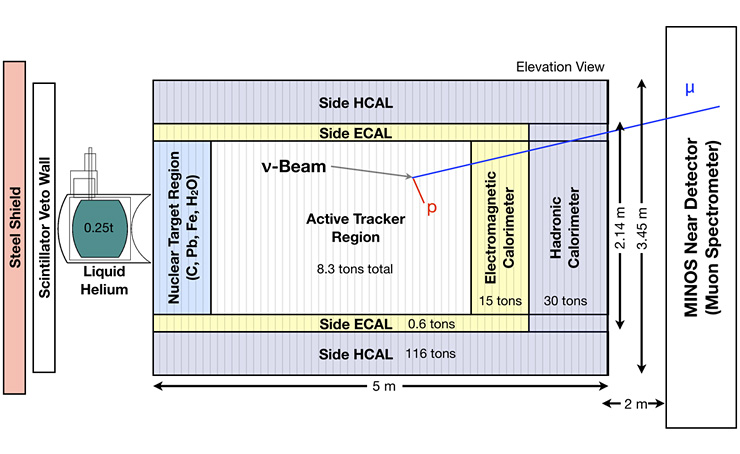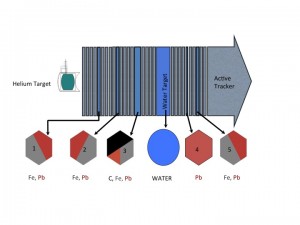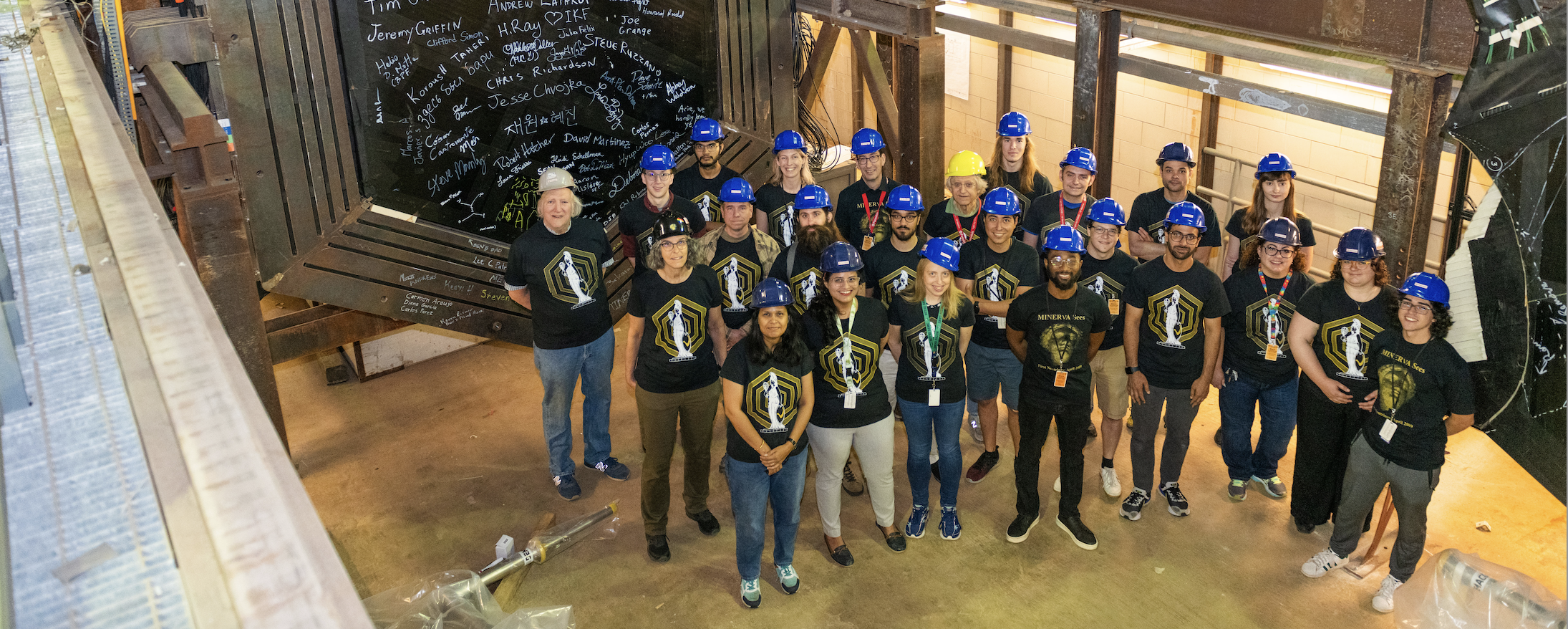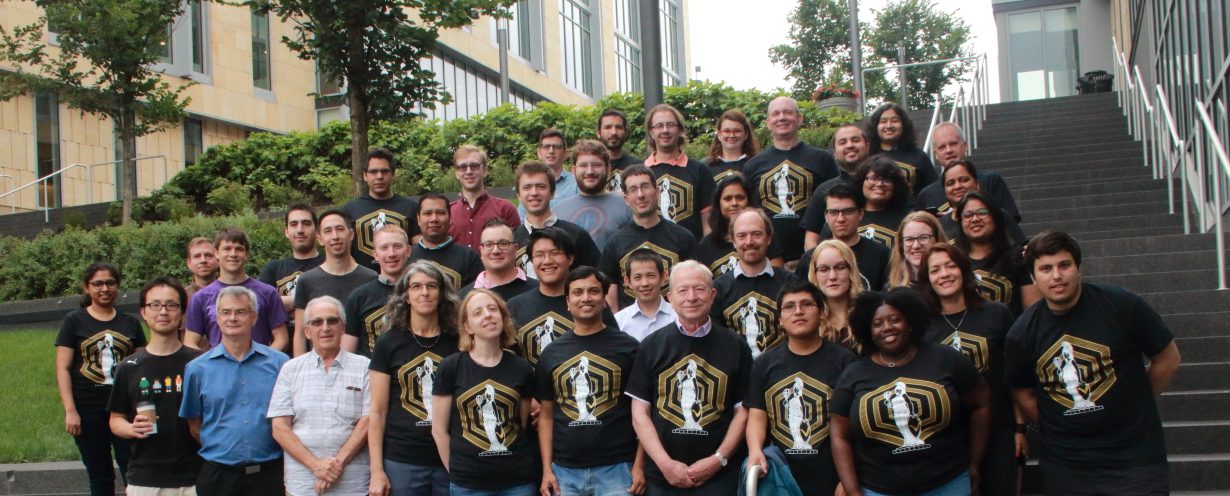MINERvA is a particle physics experiment, located at Fermi National Accelerator Laboratory in Batavia, Illinois. MINERvA was designed to perform high-precision measurements of neutrino interactions on a wide variety of materials, including water, helium, carbon, iron, lead, and plastic.
MINERvA is located 100 meters underground, and sits directly in front of the MINOS near detector. The source of MINERvA’s neutrino beam is the Neutrinos at the Main Injector beamline, or NuMI. NuMI also provides a beam of neutrinos for the MINOS and NOvA near detectors and the MINOS and NOvA far detectors located in the Soudan mine and on the border of Minnesota and Canada, respectively.
The NuMI neutrino beam is created by firing protons from Fermilab’s Main Injector into a carbon target resembling a yardstick , located inside of a magnetic focusing horn. The interaction of protons with the target produces a stream of positively and negatively charged particles. The horn produces a magnetic field used to focus either the positive or negative particles into a 675 meter long decay pipe. There the particles decay in flight to produce muons and muon neutrinos (from positive particles) or anti-muons and muon anti-neutrinos (from negative particles). The approximately 240 meters of rock and muon absorbers between the end of the decay region and the near detector hall absorb all particles except the neutrinos, creating a clean neutrino beam for use by the particle detectors.
The NuMI detector hall at Fermilab is located 105 meters underground, and contains MINERvA, the MINOS near detector, and the NOvA near detector. The center of the neutrino beam passes through MINERvA , followed by the MINOS near detector, before continuing on its journey through the Earth to the Soudan mine.
Neutrinos passing through a particle detector will collide with nuclei in the various materials making up the detector. These interactions produce ionizing radiation and secondary charged particles that leave measurable energy deposits in the detector. These energy deposits are used to identify and study the neutrino interactions.

Side-view of the MINERvA experiment. The neutrino beam travels left to right through the various detector components.
(Credit: Fermilab)
Moving from the front to the back of the MINERvA detector, the neutrino beam first sees a wall of steel, followed by another wall of solid scintillator. This so-called “veto wall” is used to identify charged particles that were created in neutrino interactions with the rock surrounding the detector hall. The neutrino beam then travels through an aluminum cryostat containing liquid helium, before entering the main body of the detector. MINERvA consists of 200 hexagonal detector panels, each one comprised of 127 triangular scintillator plastic strips with fiber optic cable running down their centers. A charged particle passing through the scintillator will produce an amount of light that is proportional to the energy that the particle lost while going through the scintillator. The many scintillator strips allow one to reconstruct a three-dimensional path, or track, of the particle through the detector, and to pinpoint the origin of the neutrino interaction.

Side-view of the MINERvA experiment. The neutrino beam travels left to right through the various detector components. (Credit: Fermilab)
The front of the detector is referred to as the nuclear target region. This region contains five detector panels made of varying configurations of solid carbon, iron, and lead, each separated by eight scintillator panels. There is also a liquid water target located between solid targets 3 and 4. This variety of nuclear targets allows researchers to compare reactions of neutrinos with the lightest nuclei target, helium, to the heaviest, lead. MINERvA is unique in using this wide variety of target material within its detector.
The nuclear target region is followed by the main bulk of the detector, the active tracker region. This area is composed solely of scintillator panels. The nuclear target and scintillator only regions are surrounded by electromagnetic and hadronic calorimeters. The calorimeter regions contain alternating strips of scintillator and lead or steel sheets. These sheets are necessary to slow down and stop charged particles created by the neutrino interactions, thus allowing MINERvA to fully measure the energy of these particles.
Highly energetic muons created in neutrino interactions are capable of escaping the MINERvA detector and entering MINOS. MINERvA uses data collected by MINOS to identify and measure these energetic particles.








